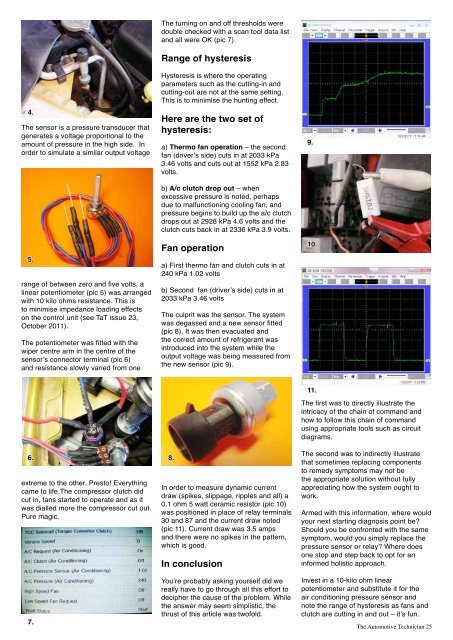What really does cause induction contamination? - TAT - The ...
What really does cause induction contamination? - TAT - The ...
What really does cause induction contamination? - TAT - The ...
You also want an ePaper? Increase the reach of your titles
YUMPU automatically turns print PDFs into web optimized ePapers that Google loves.
4.<br />
<strong>The</strong> sensor is a pressure transducer that<br />
generates a voltage proportional to the<br />
amount of pressure in the high side. In<br />
order to simulate a similar output voltage<br />
5.<br />
range of between zero and five volts, a<br />
linear potentiometer (pic 5) was arranged<br />
with 10 kilo ohms resistance. This is<br />
to minimise impedance loading effects<br />
on the control unit (see TaT issue 23,<br />
October 2011).<br />
<strong>The</strong> potentiometer was fitted with the<br />
wiper centre arm in the centre of the<br />
sensor’s connector terminal (pic 6)<br />
and resistance slowly varied from one<br />
<strong>The</strong> turning on and off thresholds were<br />
double checked with a scan tool data list<br />
and all were OK (pic 7).<br />
Range of hysteresis<br />
Hysteresis is where the operating<br />
parameters such as the cutting-in and<br />
cutting-out are not at the same setting.<br />
This is to minimise the hunting effect.<br />
Here are the two set of<br />
hysteresis:<br />
a) <strong>The</strong>rmo fan operation – the second<br />
fan (driver’s side) cuts in at 2033 kPa<br />
3.46 volts and cuts out at 1552 kPa 2.83<br />
volts.<br />
b) A/c clutch drop out – when<br />
excessive pressure is noted, perhaps<br />
due to malfunctioning cooling fan, and<br />
pressure begins to build up the a/c clutch<br />
drops out at 2928 kPa 4.6 volts and the<br />
clutch cuts back in at 2336 kPa 3.9 volts.<br />
Fan operation<br />
a) First thermo fan and clutch cuts in at<br />
240 kPa 1.02 volts<br />
b) Second fan (driver’s side) cuts in at<br />
2033 kPa 3.46 volts<br />
<strong>The</strong> culprit was the sensor. <strong>The</strong> system<br />
was degassed and a new sensor fitted<br />
(pic 8). It was then evacuated and<br />
the correct amount of refrigerant was<br />
introduced into the system while the<br />
output voltage was being measured from<br />
the new sensor (pic 9).<br />
9.<br />
10.<br />
11.<br />
<strong>The</strong> first was to directly illustrate the<br />
intricacy of the chain of command and<br />
how to follow this chain of command<br />
using appropriate tools such as circuit<br />
diagrams.<br />
6. 8.<br />
extreme to the other. Presto! Everything<br />
came to life.<strong>The</strong> compressor clutch did<br />
cut in, fans started to operate and as it<br />
was dialled more the compressor cut out.<br />
Pure magic.<br />
In order to measure dynamic current<br />
draw (spikes, slippage, ripples and all) a<br />
0.1 ohm 5 watt ceramic resistor (pic 10)<br />
was positioned in place of relay terminals<br />
30 and 87 and the current draw noted<br />
(pic 11). Current draw was 3.5 amps<br />
and there were no spikes in the pattern,<br />
which is good.<br />
In conclusion<br />
<strong>The</strong> second was to indirectly illustrate<br />
that sometimes replacing components<br />
to remedy symptoms may not be<br />
the appropriate solution without fully<br />
appreciating how the system ought to<br />
work.<br />
Armed with this information, where would<br />
your next starting diagnosis point be?<br />
Should you be confronted with the same<br />
symptom, would you simply replace the<br />
pressure sensor or relay? Where <strong>does</strong><br />
one stop and step back to opt for an<br />
informed holistic approach.<br />
7.<br />
You’re probably asking yourself did we<br />
<strong>really</strong> have to go through all this effort to<br />
decipher the <strong>cause</strong> of the problem. While<br />
the answer may seem simplistic, the<br />
thrust of this article was twofold.<br />
Invest in a 10-kilo ohm linear<br />
potentiometer and substitute it for the<br />
air conditioning pressure sensor and<br />
note the range of hysteresis as fans and<br />
clutch are cutting in and out – it’s fun.<br />
<strong>The</strong> Automotive Technician 25
















